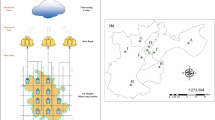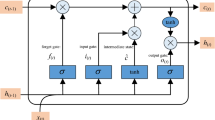Abstract
High concentration PM2.5 may cause serious damage to human health. Accurate PM2.5 concentration forecasting can provide the public with timely and effective PM2.5 pollution warning information. In the current mainstream studies, most existing air pollution forecasting models use only one predictor, of which the accuracy and stability can be further improved. In this study, a novel hybrid ensemble model with three deep learning predictors is proposed for hourly PM2.5 concentration forecasting. In the proposed model, the complementary ensemble empirical mode decomposition (CEEMD) is used to extract the features in the PM2.5 data series to reduce its complexity. Three deep neural networks are used as predictors for data forecasting, including deep belief network (DBN), long short-term memory network (LSTM), and multilayer perceptron (MLP). Each predictor is given a weight, and the imperial competition algorithm (ICA) is used to optimize weights to obtain the best forecasting result. Two groups of PM2.5 concentration data from Shanghai are used to validate the model. The experimental results show that the proposed model has high accuracy and robustness, and can outperform all comparison models.





Similar content being viewed by others
Abbreviations
- ARMA:
-
autoregressive integrated moving average
- BEMD:
-
bivariate empirical mode decomposition
- BP:
-
back propagation
- CEEMD:
-
complementary ensemble empirical mode decomposition
- DBN:
-
deep belief network
- ENN:
-
Elman neural network
- GA:
-
genetic algorithm
- ICA:
-
imperial competition algorithm
- LSTM:
-
long short-term memory network
- MAE:
-
mean absolute error
- MAPE:
-
mean absolute percentage error
- MARS:
-
multivariate adaptive regression splines
- MLP:
-
multilayer perceptron
- MLPI:
-
utilized interval multilayer perceptron
- PSO:
-
particle swarm optimization
- r:
-
Pearson correlation coefficient
- RBM:
-
restricted Boltzmann machine
- RMSE:
-
root mean square error
- RNN:
-
recurrent neural network
- SVR:
-
support vector regression
- WT:
-
wavelet decomposition
References
Atashpaz-Gargari E, Lucas C, Ieee (2007) Imperialist competitive algorithm: an algorithm for optimization inspired by imperialistic competition. 2007 Ieee Congress on Evolutionary Computation, Vols 1–10, Proceedings. Ieee, New York. https://doi.org/10.1109/cec.2007.4425083
Bolandnazar E, Rohani A, Taki M (2020) Energy consumption forecasting in agriculture by artificial intelligence and mathematical models. Energ Source Part A 42(13):1618–1632. https://doi.org/10.1080/15567036.2019.1604872
Cheng Y, Zhang H, Liu ZH, Chen LF, Wang P (2019) Hybrid algorithm for short-term forecasting of PM2.5 in China. Atmos Environ 200:264–279. https://doi.org/10.1016/j.atmosenv.2018.12.025
Feng X, Li Q, Zhu Y, Hou J, Jin L, Wang J (2015) Artificial neural networks forecasting of PM2.5 pollution using air mass trajectory based geographic model and wavelet transformation. Atmos Environ 107:118–128. https://doi.org/10.1016/j.atmosenv.2015.02.030
Feng SZ, Jiang F, Jiang ZQ, Wang HM, Cai Z, Zhang L (2018) Impact of 3DVAR assimilation of surface PM2.5 observations on PM2.5 forecasts over China during wintertime. Atmos Environ 187:34–49. https://doi.org/10.1016/j.atmosenv.2018.05.049
He JY, Christakos G (2018) Space-time PM2.5 mapping in the severe haze region of Jing-Jin-Ji (China) using a synthetic approach. Environ Pollut 240:319–329. https://doi.org/10.1016/j.envpol.2018.04.092
Huang NE, Shen Z, Long SR (1999) A new view of ntaar water waves: the Hilbert spectrum. Annu Rev Fluid Mech 31:417–457. https://doi.org/10.1146/annurev.fluid.31.1.417
Islam MM, Sharmin M, Ahmed F (2020) Predicting air quality of Dhaka and Sylhet divisions in Bangladesh: a time series modeling approach. Air Qual Atmos Health:9. https://doi.org/10.1007/s11869-020-00823-9
Koo JW, Wong SW, Selvachandran G, Long HV, Son L (2020) Prediction of air pollution index in Kuala Lumpur using fuzzy time series and statistical models. Air Qual Atmos Health 13(1):77–88. https://doi.org/10.1007/s11869-019-00772-y
Kow PY, Wang YS, Zhou YL, Kao IF, Issermann M, Chang LC, Chang FJ (2020) Seamless integration of convolutional and back-propagation neural networks for regional multi-step-ahead PM2.5 forecasting. J Clean Prod 261:14. https://doi.org/10.1016/j.jclepro.2020.121285
Lei MT, Monjardino J, Mendes L, Goncalves D, Ferreira F (2019) Macao air quality forecast using statistical methods. Air Qual Atmos Health 12(9):1049–1057. https://doi.org/10.1007/s11869-019-00721-9
Liu H, Chen C (2020) Spatial air quality index prediction model based on decomposition, adaptive boosting, and three-stage feature selection: a case study in China. J Clean Prod 265:121777. https://doi.org/10.1016/j.jclepro.2020.121777
Liu H, Jin KR, Duan Z (2019) Air PM2.5 concentration multi-step forecasting using a new hybrid modeling method: comparing cases for four cities in China. Atmos Pollut Res 10(5):1588–1600. https://doi.org/10.1016/j.apr.2019.05.007
Liu W, Liu WD, Gu JW (2020) Forecasting oil production using ensemble empirical model decomposition based long short-term memory neural network. J Pet Sci Eng 189:14. https://doi.org/10.1016/j.petrol.2020.107013
Niu MF, Wang YF, Sun SL, Li YW (2016) A novel hybrid decomposition-and-ensemble model based on CEEMD and GWO for short-term PM2.5 concentration forecasting. Atmos Environ 134:168–180. https://doi.org/10.1016/j.atmosenv.2016.03.056
Pirmoradi S, Teshnehlab M, Zarghami N, Sharifi A (2020) The self-organizing restricted Boltzmann machine for deep representation with the application on classification problems. Expert Syst Appl 149:11. https://doi.org/10.1016/j.eswa.2020.113286
Tang SR, Chen WG, Jin LF, Zhang H, Li YQ, Zhou Q, Zeng W (2020) SWCNTs-based MEMS gas sensor array and its pattern recognition based on deep belief networks of gases detection in oil-immersed transformers (vol 312, 127998, 2020). Sensors Actuators B Chem 314:1. https://doi.org/10.1016/j.snb.2020.128051
Ventura LMB, Pinto FD, Soares LM, Luna AS, Gioda A (2019) Forecast of daily PM2.5 concentrations applying artificial neural networks and Holt-Winters models. Air Qual Atmos Health 12(3):317–325. https://doi.org/10.1007/s11869-018-00660-x
Wang J, Du P, Hao Y, Ma X, Niu T, Yang W (2020) An innovative hybrid model based on outlier detection and correction algorithm and heuristic intelligent optimization algorithm for daily air quality index forecasting. J Environ Manag 255:109855. https://doi.org/10.1016/j.jenvman.2019.109855
Winterbottom CJ, Shah RJ, Patterson KC, Kreider ME, Panettieri RA, Rivera-Lebron B, Miller WT, Litzky LA, Penning TM, Heinlen K, Jackson T, Localio AR, Christie JD (2018) Exposure to ambient particulate matter is associated with accelerated functional decline in idiopathic pulmonary fibrosis. Chest 153(5):1221–1228. https://doi.org/10.1016/j.chest.2017.07.034
Yeh JR, Shieh JS, Huang NE (2010) Complementary ensemble empirical mode decomposition: a novel noise enhanced data analysis method. Adv Adapt Data Anal 2(2):135–156
Zhao GM, Li N, Li B, Li WW, Liu YC, Chai T (2020) ANN model for predicting acrylonitrile wastewater degradation in supercritical water oxidation. Sci Total Environ 704:8. https://doi.org/10.1016/j.scitotenv.2019.135336
Zhu SL, Lian XY, Liu HX, Hu JM, Wang YY, Che JX (2017) Daily air quality index forecasting with hybrid models: a case in China. Environ Pollut 231:1232–1244. https://doi.org/10.1016/j.envpol.2017.08.069
Zhu SL, Qiu XL, Yin YR, Fang M, Liu XR, Zhao XJ, Shi YJ (2019) Two-step-hybrid model based on data preprocessing and intelligent optimization algorithms (CS and GWO) for NO2 and SO2 forecasting. Atmos Pollut Res 10(4):1326–1335. https://doi.org/10.1016/j.apr.2019.03.004
Zhu S, Sun J, Liu Y, Lu M, Liu X (2020) The air quality index trend forecasting based on improved error correction model and data preprocessing for 17 port cities in China. Chemosphere 252:126474. https://doi.org/10.1016/j.chemosphere.2020.126474
Acknowledgments
The study is fully supported by the National Natural Science Foundation of China (61873283), the Changsha Science & Technology Project (KQ1707017) and the Innovation Driven Project of the Central South University (2019CX005).
Author information
Authors and Affiliations
Corresponding author
Ethics declarations
Conflict of interest
The authors declared that they have no conflict of interest in this work.
Additional information
Publisher’s note
Springer Nature remains neutral with regard to jurisdictional claims in published maps and institutional affiliations.
Rights and permissions
About this article
Cite this article
Liu, H., Dong, S. A novel hybrid ensemble model for hourly PM2.5 forecasting using multiple neural networks: a case study in China. Air Qual Atmos Health 13, 1411–1420 (2020). https://doi.org/10.1007/s11869-020-00895-7
Received:
Accepted:
Published:
Issue Date:
DOI: https://doi.org/10.1007/s11869-020-00895-7




